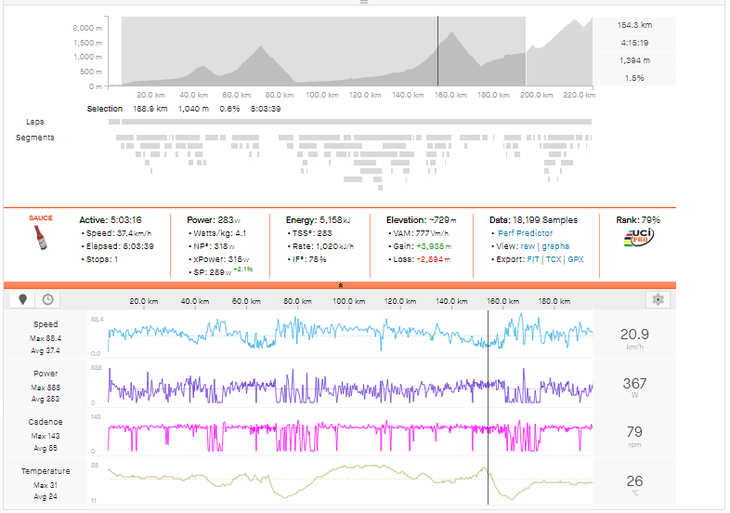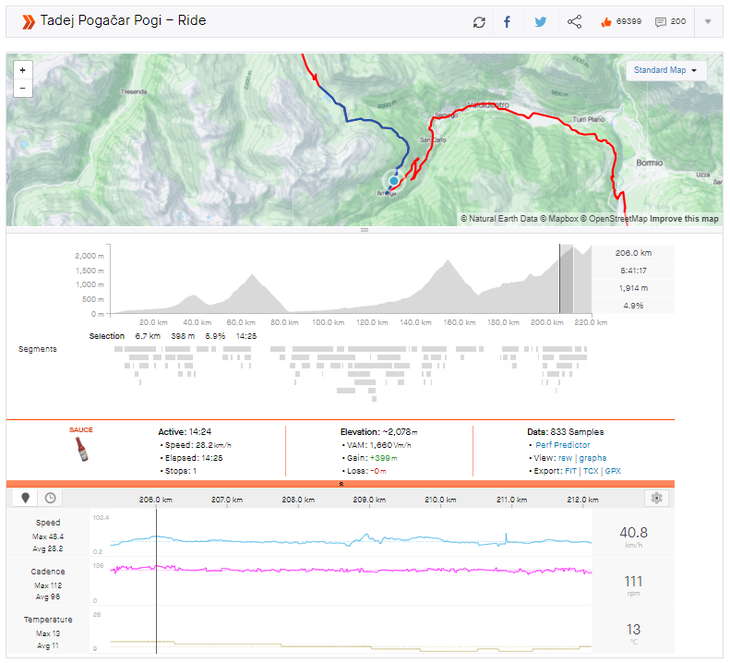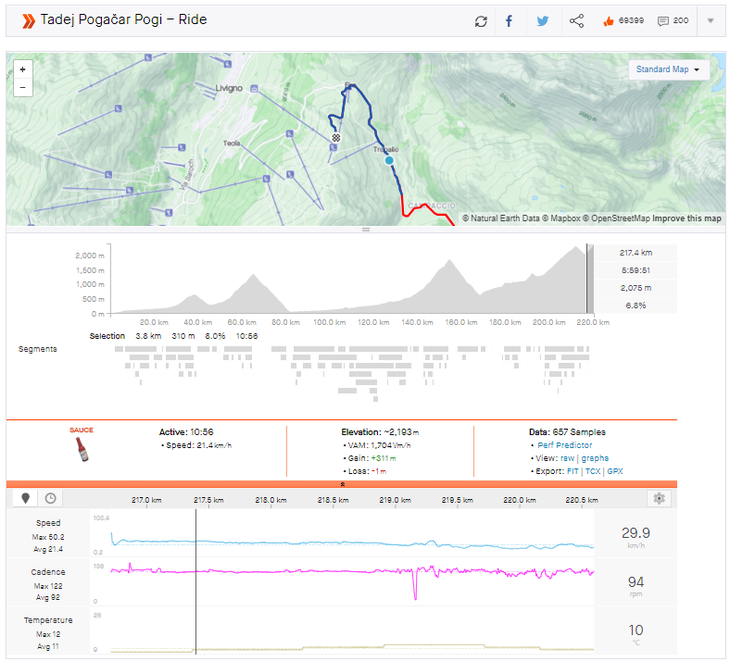When Rafał Majka got out of the saddle with 15km to go on stage 15 of the Giro d’Italia, we all knew what was coming. Tadej Pogačar accelerated at nearly 1,000w to drop his rivals before settling into a 6.9w/kg pace at over 2,000 meters altitude.
In this article, we’re going to take a closer look at one of Tadej Pogačar’s best-ever performances. The Slovenian has had many in his career, but this high-altitude performance is arguably his best. Here’s why.
Queen Stage With Over 5,700 Meters of Elevation Gain
The 15th stage of the Giro was one of the hardest in modern cycling history. As stages get shorter and shorter, we’re rarely treated to 200km+ epics anymore, especially those with high mountain passes. Add high altitude to the mix, and you get a Sunday stage of biblical proportions.
At 222 km with 5,751 meters of climbing, the stage was equally feared by sprinters, GC riders, and everyone in between. Plus, the majority of the climbing came in the second half of the stage where the riders would eventually finish atop the Mottolino in Livigno.
Pogačar was leading the Giro by over three minutes at the start of Stage 15, but he has a complicated history with high altitude. Of all the dominating performances that Pogačar has conjured up in recent years, his capitulations at high altitude are just as infamous.
The 25-year-old lost minutes on Col du Granon, Mont Ventoux, and Col de la Loze—all high-altitude finishes after more than 4,000 meters of climbing. Pogačar said that he and his team had been preparing for this Giro stage since December, but would they get it right this time?
The Hard Part Before the Hard Part
While most cycling fans will remember Pogačar’s ascent of the final climb, it’s easy to forget the first five hours of the stage. Ridden at nearly 40 kph with 4,000 meters of climbing, this part of the stage would destroy most amateurs.
Thymen Arensman rode in basically the same position as Pogačar until the final climb. Both riders were protected by their teammates at the front of the peloton, but that didn’t mean they were riding easy. Arensman burned ~5,150 kJs in the first five hours of the stage, a rate of over 1,000 kJs per hour. Remember, this isn’t even the hard part yet.

Arensman – First five hours of Stage 15
Time: 5:03:16
Average Power: 283w (4.1w/kg)
Normalized Power: 318w (4.7w/kg)
At the base of the Passo di Foscagno with about 25 km to go, the breakaway still had three and a half minutes on Pogačar and the rest of the peloton. Typically, you would expect UAE Team Emirates to slowly lift the pace, kilometer by kilometer. Then, with 3-6 km to go, Pogačar would launch off Majka’s wheel with a monstrous attack.
That was the expectation.
Pogačar Destroys Everyone at More Than 2,300 Meters Altitude
The alarm bells started ringing when Majka hit the front with 16 km to go, churning a huge gear and stringing the peloton into a single file line. It wasn’t long before Pogačar went into orbit, peaking at 920w during his attack, according to Velon CC.
While riding at 2,000+ meters altitude, Pogačar pushed 450w (7w/kg) for the first five minutes of his attack. It shouldn’t come as a surprise that no one even tried to jump on his wheel.
View this post on Instagram
Pogačar – First five minutes of his attack
Average Power: 450w (~7w/kg)
Peak Power: 920w (~14.4w/kg)
It was a textbook Pogačar attack, as we can see from his ride file on Strava. Majka accelerated out of a switchback, causing an accordion effect that strung out the riders behind him. Then, Pogačar attacked at nearly 1,000w, pedaling at a high cadence for more than 30 seconds and reaching 43 kph on a 6 percent grade.
From his attack to the top of the Foscagno, we estimate that Pogačar pushed ~6.8w/kg for 14 minutes at an average altitude of 2,078 meters. When adjusted for altitude, these numbers are in line with the best performances we’ve seen in modern cycling (Pogačar and Jonas Vingegaard have pushed 7.3-7.5w/kg for 12-15 minutes in the best performances of their careers).
For context, Arensman pushed 5.5w/kg (~6w/kg when adjusted for altitude) on the same section of the Foscagno, and he was still two minutes and 18 seconds slower than Pogačar.

Pogačar – Attack on the Passo di Foscagno
Time: 14:24
Average Power: 435w (~6.8w/kg)
Arensman – Same section on the Passo di Foscagno
Time: 16:42
Average Power: 378w (5.5w/kg)
After a super-fast descent to the base of the Mottolino, Pogačar continued at his attacking pace to catch and pass the last survivor from the breakaway, Nairo Quintana. Pogačar continued to gain time on the final climb, and he won the stage in Livigno with a time of 6 hours 11 minutes and 43 seconds. Dani Martinez and Geraint Thomas were the best of the rest from the GC group, finishing two minutes and 50 seconds behind Pogačar.

Pogačar – Mottolino
Time: 10:56
Average Power: 430w (~6.7w/kg)
Average Elevation: 2,193 meters
Dani Martinez – Mottolino
Time: 12:18
Average Power: 368w (6w/kg)
In the final four kilometers of Stage 15, Pogačar was 218 kilometers and 6,000+ kJs into the stage, riding from 2,100 meters to 2,350 meters altitude. Based on all historical data, Pogačar should have been floundering. Instead, he was rewriting the history books by continuing to push more than 6.5w/kg all the way to the finish. In the final 4 km, Pogačar still gained a minute and 30 seconds on the GC group while riding solo. We’re running out of superlatives at this point, but that performance was mind-boggling. After stage 15, Pogačar’s lead grew to more than six minutes.
Power Analysis data courtesy of Strava
Strava sauce extension
Riders:
